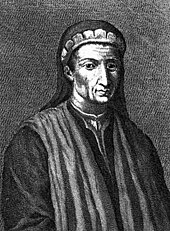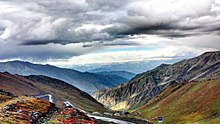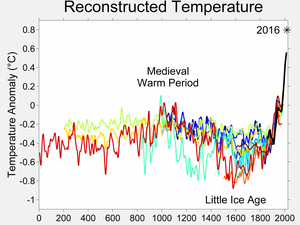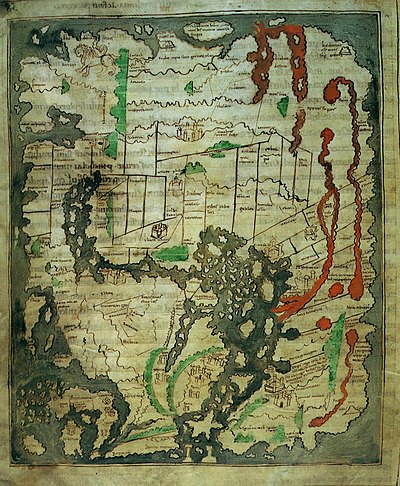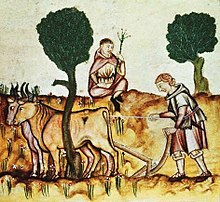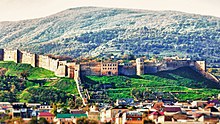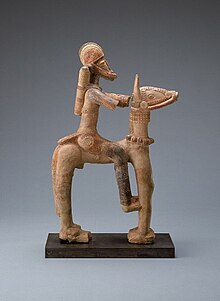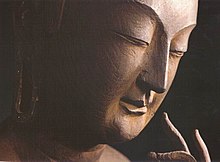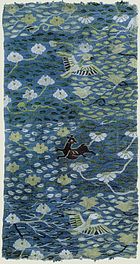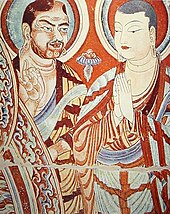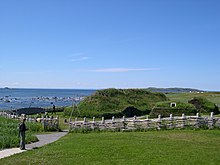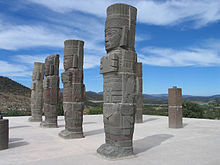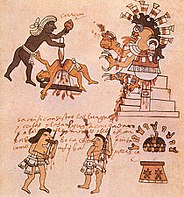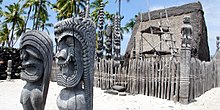Post-classical history
Definition
Post-classical history (also called the Post-Antiquity era, Post-Ancient Era, or Pre-Modern Era) is a periodization commonly used by the school of "world history" instead of Middle Ages (Medieval), which is roughly synonymous. The period runs from about 500 to 1450 CE though there may be regional differences and debates. The era was globally characterized by the expansion of civilizations geographically, the development of three of the great world religions (Christianity, Islam, and Buddhism), and development of networks of trade between civilizations.In Asia, the spread of Islam created a new empire and Islamic Golden Age with trade between the Asian, African and European continents, and advances in science in the medieval Islamic world. East Asiaexperienced the full establishment of power of Imperial China, which established several prosperous dynasties influencing Korea, Vietnam, and Japan. Religions such as Buddhism and Neo-Confucianismspread. Gunpowder was originally developed in China during the post-classical era. The Mongol Empire connected Europe and Asia creating safe trade and stability between the two regions.
Terminology and periodization issues
Post-classical history is a periodization used by historians employing a "world history" approach to history, specifically the school developed during the late 20th and early 21st centuries. Outside of world history, it is also sometimes used to avoid erroneous pre-conceptions around the terms "Middle Ages", "Medieval" and "Dark Ages" (see medievalism).
Post-classical corresponds roughly from 500 to 1450 CE. Beginning and ending dates might change depending on the region, with the period beginning at the end of the previous classical period: Han China (ending in 220), the Western Roman Empire (in 476), the Gupta Empire (in the 550s), and the Sasanian Empire (in 651).
Post-classical is one of the five or six major periods world historians use: (1) early civilization; (2) classical societies; (3) post-classical; (4) early modern; (5) long nineteenth century; and (6) contemporary or modern era. Sometimes the 19th century and modern are combined. Although post-classical is synonymous with the Middle Ages of Western Europe, the term "post-classical" is not necessarily a member of the three traditional divisions of Western European history: classical, middle and modern (see tripartite periodisation).
World history looks at common themes occurring across multiple cultures and regions. It recognizes that post-classical history is mainly in the sphere of Afro-Eurasia.Historians recognize the difficulties of periodization and common themes for the Americas since they were following their own historical developments before the Columbian Exchange.
Main trends
The Post-classical era saw several common developments or themes. There was the expansion and growth of civilization into new geographic areas; the rise and/or spread of the three major world, or missionary, religions; and a period of rapidly expanding trade and trade networks.
Growth of civilization
First was the expansion and growth of civilization into new geographic areas across Asia, Africa, Europe, Mesoamerica, and western South America. However as noted by world historian Peter N. Stearns, there were no common global political trends during the post-classical period, rather it was a period of loosely organized states and other developments, but no common political patterns emerged. In Asia, China continued its historic dynastic cycle and became more complex, improving its bureaucracy. The creation of the Islamic Empires established a new power in the Middle East, North Africa, and Central Asia. Africa created the Songhai and Malikingdoms in the West. The fall of Roman civilization not only left a power vacuum for the Mediterranean and Europe, but forced certain areas to build what some historians might call new civilizations entirely. An entirely different political system was applied in Western Europe (i.e. feudalism), as well as a different society (i.e. manorialism). But the once East Roman Empire, Byzantium, retained many features of old Rome, as well as Greek and Persian similarities. Kiev Rus' and subsequently Russia began development in Eastern Europe as well. In the isolated Americas, Mesoamerica saw the building of the Aztec Empire, while the Andean region of South America saw the establishment of the Inca Empire.
Spread of religion
The growth and geographical spread of the three major world, or missionary, religions occurred, with Islam seeing a large expansion during this time. Christianity continued into Scandinavia, the Baltic area, and the British Isles – ousting the old pagan religions; an attempt was even made to incur upon the Middle East during the Crusades. The split of the Catholic Church in Western Europe and the Orthodox Church in Eastern Europe encouraged religious and cultural diversity in Eurasia. Additionally, Buddhism spread from India into China and flourished there briefly before using it as a hub to spread to Japan, Korea, and Vietnam; a similar effect occurred with Confucian revivalism in the later centuries. Once again, however, the most prominent world religion at the time was Islam. Starting in the Arabian Peninsula, it unified the warring Bedouin clans and through conquest, trade, and missionaries, spread to Persia, Indonesia, Central Asia, India, North Africa, West Africa and the Iberian Peninsula.
Trade and communication
Finally, communication and trade across Afro-Eurasia increased rapidly. The Silk Road continued to spread cultures and ideas through trade and throughout Europe, Asia, and Africa. Trade networks were established between West Europe, Byzantium, early Russia, the Islamic Empires, and the Far Eastern civilizations. In Africa the earlier introduction of the Camel allowed for a new and eventually large Trans-Saharan trade which connected Sub-Saharan West Africa to Eurasia. The Islamic Empires adopted many Greek, Roman, and Indian advances and spread them through the Islamic sphere of influence, allowing these developments to reach Europe, North and West Africa, and Central Asia. Islamic sea trade helped connect these areas, including those in the Indian Oceanand in the Mediterranean, replacing Byzantium in the latter region. The Christian Crusades into the Middle East (as well as Muslim Spain and Sicily) brought Islamic science, technology, and goods to Western Europe. Western trade into East Asia was pioneered by Marco Polo. Importantly, China began the sinicization (or Chinese influence) of regions like Japan, Korea, and Vietnam through trade and conquest. Finally, the growth of the Mongol Empire in Central Asia established safe trade such as to allow goods, cultures, ideas, and disease to spread between Asia, Europe, and Africa.
The Americas had their own trade network, however theirs was limited by the lack of draft animals and the wheel. In Oceania some of the island chains of Polynesia and Micronesia also engaged in trade with one another.
Climate
During Post-Classical times, there is evidence that many regions of the world were effected similarly by global climate conditions however, direct effects in temperature and precipitation varied by region. According to Intergovernmental Panel on Climate Change changes did not all occur sanctimoniously at once. Generally however studies found that temperatures were relatively warmer, in the eleventh century, but colder by the early seventeenth century. It is uncertain the degree of climate change which occurred in all regions across the world, and whether such changes were all part of a global trend. Climate trends seemed to be more recognizable along the Northern Hemisphere than the Southern Hemisphere.
There are climate periods that could be roughly said to account for large scale climate trends in the Post Classical Period. These include the Late Antique Little Ice Age, the Medieval Warm Period and the Little Ice Age. The Extreme Weather Events of 536–537 were likely initiated by the eruption of the Lake llopango caldera in El Savador. Sulfate emitted into the air initiated global cooling, migrations and crop failures world-wide possibly intensifying an already cooler time period. Records show that the world's temperature remained colder on average for at least a century afterwards.
The Medieval Warming Period from 950–1250 occurred mostly throughout the northern hemisphere causing many areas to have warmer summers, the high temperatures would only be surpassed by the Global Warming of the 20th/21st centuries. It has been hypothesized that the warm of temperatures allowed the Norse to colonize Greenland, due to ice-free waters at the time. Outside of Europe there is evidence of warming conditions, including higher temperatures in China and major North American droughts which adversely effected numerous cultures.
After 1250, glaciers began to expand in Greenland, cooling the entire North Atlantic.In the 14th century, the growing season in Europe became unreliable, meanwhile in China the cultivation of Oranges were driven southward by colder temperatures. Especially in Europe, the Little Ice Age had large cultural ramifications. The Little Ice Age would persist until the industrial revolution, far beyond the time-frame of the Post Classical Period. The causes for the little Ice-Age are unclear, possible explanations include sunspots, orbital cycles of the Earth, volcanic activity, ocean circulation, and population decline.
Timeline
This timetable gives a basic overview of states, cultures and events which transpired roughly between the years 400 and 1500. Sections are broken by political and geographic location.
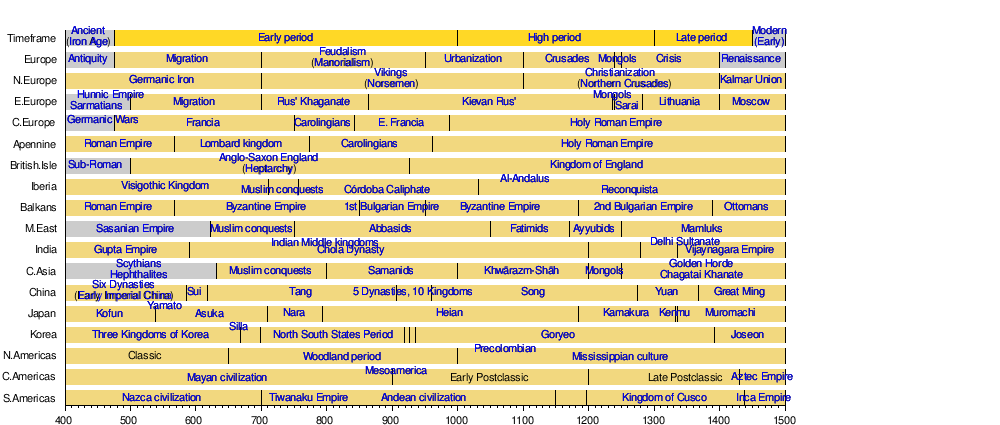
-
-
- Middle Ages Divisions, Middle Ages Themes
-
History by region in the Old-World
Europe
In Europe, Western civilization reconstituted after the Fall of the Western Roman Empire into the period now known as the Early Middle Ages (500–1000), during which the Catholic Church unified the region. The Early Middle Ages saw a continuation of trends begun in Late Antiquity: depopulation, deurbanization, and increased barbarian invasion. From the 7th until the 11th centuries Arabs, Magyars and Norse were all threats to the Christian Kingdoms. In western Europe the Frankish king Charlemagne attempted to kindle the rise of culture and science in the Carolingian Renaissance. In the year 800 Charlemagne founded the Holy Roman Empire in attempt to resurrect Classical Rome.
In Eastern Europe, the Eastern Roman Empire survived in what is now called the Byzantine Empire. Ruled by religious Christian Orthodox emperors. The Byzantine Eastern Orthodox Church Christianized the Kieven Rus, who were the foundation of modern day Russia and Ukraine. Byzantium flourished as the leading power and trade center in its region until it was overshadowed by Italian City States and the Islamic Ottoman Empire near the end of the Middle Ages.
Later in the period, the creation of the feudal system allowed greater degrees of military and agricultural organization. There was sustained urbanization in northern and western Europe. Later developments were marked by manorialism and feudalism, and evolved into the prosperous High Middle Ages. After 1000 the character of the Christian kingdoms that had emerged from Rome's collapse changed in their cultural and societal character.
During the High Middle Ages (c. 1000–1300), Christian-oriented art and architecture flourished and the Crusades were mounted to recapture the Holy Land from Muslim control. The influence of the emerging nation-state was tempered by the ideal of an international Christendom. The codes of chivalry and courtly love set rules for proper behavior, while the Scholastic philosophers attempted to reconcile faith and reason. This time would be a major underlying cause for the Renaissance. By the turn of the 16th century European or Western Civilization would be engaging in the Age of Discovery.
The term "Middle Ages" first appears in Latin in the 15th century and reflects the view that this period was a deviation from the path of classical learning, a path supposedly reconnected by Renaissance scholarship.
Middle East
The Arabian peninsula and the surrounding Middle East and Near East regions saw dramatic change during the Postclassical Era caused primarily by the spread of Islam and the establishment of the Arabian Empires.
In the 5th century, the Middle East was separated by empires and their spheres of influence; the two most prominent were the Sasanian Empire of the Persians in what is now Iran and Iraq, and the Byzantine Empire in Anatolia (modern-day Turkey). The Byzantines and Sasanians fought with each other continually, a reflection of the rivalry between the Roman Empire and the Persian Empire seen during the previous five hundred years. The fighting weakened both states, leaving the stage open to a new power. Meanwhile the nomadic Bedouin tribes who dominated the Arabian desert saw a period of tribal stability, greater trade networking and a familiarity with Abrahamic religions or monotheism.
While the Byzantine Roman and Sassanid Persian empires were both weakened by the Byzantine–Sasanian War of 602–628, a new power in the form of Islam grew in the Middle East under Muhammad in Medina. In a series of rapid Muslim conquests, the Rashidun army, led by the Caliphs and skilled military commanders such as Khalid ibn al-Walid, swept through most of the Middle East, taking more than half of Byzantine territory in the Arab–Byzantine wars and completely engulfing Persia in the Muslim conquest of Persia. It would be the Arab Caliphates of the Middle Ages that would first unify the entire Middle East as a distinct region and create the dominant ethnic identity that persists today. These Caliphates included the Rashidun Caliphate, Umayyad Caliphate, Abbasid Caliphate, and later the Turkic based Seljuq Empire. After Muhammad introduced Islam, it jump-started Middle Eastern culture into an Islamic Golden Age, inspiring achievements in architecture, the revival of old advances in science and technology, and the formation of a distinct way of life. Muslims saved and spread Greek advances in medicine, algebra, geometry, astronomy, anatomy, and ethics that would later finds it way back to Western Europe.
The dominance of the Arabs came to a sudden end in the mid-11th century with the arrival of the Seljuq Turks, migrating south from the Turkic homelands in Central Asia. They conquered Persia, Iraq (capturing Baghdad in 1055), Syria, Palestine, and the Hejaz. This was followed by a series of Christian Western Europe invasions. The fragmentation of the Middle East allowed joint European forces mainly from England, France, and the emerging Holy Roman Empire, to enter the region. In 1099 the knights of the First Crusade captured Jerusalem and founded the Kingdom of Jerusalem, which survived until 1187, when Saladin retook the city. Smaller crusader fiefdoms survived until 1291. In the early 13th century, a new wave of invaders, the armies of the Mongol Empire, swept through the region, sacking Baghdad in the Siege of Baghdad (1258) and advancing as far south as the border of Egypt in what became known as the Mongol conquests. The Mongols eventually retreated in 1335, but the chaos that ensued throughout the empire deposed the Seljuq Turks. In 1401, the region was further plagued by the Turko-Mongol, Timur, and his ferocious raids. By then, another group of Turks had arisen as well, the Ottomans.
Africa
During the Postclassical Era, Africa was both culturally and politically affected by the introduction of Islam and the Arabic empires. This was especially true in the north, the Sudan region, and the east coast. However, this conversion was not complete nor uniform among different areas, and the low-level classes hardly changed their beliefs at all. Prior to the migration and conquest of Muslims into Africa, much of the continent was dominated by diverse societies of varying sizes and complexities. These were ruled by kings or councils of elders who would control their constituents in a variety of ways. Most of these peoples practiced spiritual, animistic religions. Africa was culturally separated between Saharan Africa (which consisted of North Africa and the Sahara Desert) and Sub-Saharan Africa (everything south of the Sahara). Sub-Saharan Africa was further divided into the Sudan, which covered everything north of Central Africa, including West Africa. The area south of the Sudan was primarily occupied by the Bantu peoples who spoke the Bantu language.
Sub Saharan Africa
After 650 approximately urbanization expanded for the first time beyond the ancient kingdoms Aksum and Nubia. The Precolonial civilizations of African Civilization can be divided into three categories based on religion. (1) Christian Civilizations on the Horn of Africa (2) Islamic Civilizations which formed in the Niger River valley in West Africa, and on the coast of East Africa and (3) Traditional Societies which adhered to native African Religions. Sub Saharan Africa was part of two large, separate trading networks, the Trans Saharan trade which bridged commerce between West and North Africa. Due to the huge profits from trade native African Islamic empires arose, including those of Ghana, Mali and Songhay. In the 14th century, Mana Masua king of Mali may have been the wealthiest person of his time. Within Mali, the city of Timbuktu was an international center of science and well known through out the Islamic World, particularly from the University of Sankore. East Africa was part of the Indian Ocean trade network, which included both Arab ruled Islamic cities on the East African Coast such as Mombasa and Traditional cities such as Great Zimbabwe which exported gold, copper and ivory to markets in the Middle East, South Asia, and Southeast Asia.
South Asia
There has been difficulty applying the word 'medieval' or 'post classical' to the history of South Asia. This section follows historian Stein Burton's definition that corresponds from the 8th century to the 16th century, more of less following the same time frame of the Post Classical Period and the European Middle Ages.
Until the 13th century, there was no less than 20 to 40 different states on the Indian Subcontinent which hosted a variety of cultures, languages, writing systems and religions. In the beginning of the time period Buddhism was predominant throughout the area with the short lived Pala Empire on the Indo Gangetic Plain sponsoring the faith's institutions. One such institution was the Buddhist Nalanda University in modern day Bihar, India was a center of scholarship and brought a divided South Asia onto the global intellectual stage. Classical India was unique for being the only country to mine gems before modern times, and to have a discipline for eye surgery.Another accomplishment was the invention of the Chaturanga game which later was exported to Europe and became Chess. In Southern India, the Hindu Kingdom of Chola gained prominence with an overseas empire that controlled parts of modern day Sri Lanka, Malaysia, and Indonesia as oversees territories and helped spread Hinduism into the historic culture of these places. In this time period, neighboring areas such as Afghanistan, Tibet, Southeast Asia were under South Asian influence.
From 1206 onward a series of Turkic Islamic invasions based from modern day Afghanistan and Iran conquered massive portions of Northern India, founding the Delhi Sultante which remained supreme until the 16th century. The Delhi Sultanate introduced Islam to the conquered populations for the first time. Native religions fared differently, Buddhism declined in South Asia vanishing in many areas but Hinduism survived and reinforced itself in areas conquered by Muslims. In the far South the Kingdom of Vijanyagar was not conquered by any Muslim state in the period. The turn of the 16th century would see the rise of a new Islamic Empire- the Mughals and the establishment of European trade posts by the Portuguese.
Southeast Asia
From the 8th century onward Southeast Asia stood to benefit from the trade taking place between South and East Asia, numerous kingdoms arose in the region due to the flow of wealth passing through the Strait of Malacca. While Southeast Asia had numerous outside influences India was the greatest source of inspiration for the region. North Vietnam as an exception was culturally closer to China for centuries due to conquest.
Since rule from the third century BCE North Vietnam continued to be subjugated by Chinese states, although they continually resisted periodically. There were three periods of Chinese Domination that spanned near 1100 years. Vietnam gained long lasting independence in the 10th century when China was divided. Nonetheless even as an independent state a sort of begrudging sinicization occurred. By the end of the Postclassical Era, Vietnam would be in control of its own Nguyễn dynasty. South Vietnam was governed by the ancient Hindu Champa Kingdom but was annexed by Vietnamese invaders.
The spread of Hinduism, Buddhism and maritime trade between China and South Asia created the foundation for Southeast Asia's first major empires. The Khemer Empire from Cambodia and Sri Vijaya from Indonesia both profited from maritime trade. During the Khmer Empire's height in the 12th century the city of Angkor Thomwas among the largest of the pre-modern world. King Jayavarman II constructed over a hundred hospitals throughout his realm.
In Indonesia, Srivijaya from the 7th through 14th century was a Thalassocracy that focused on maritime city states and trade. Controlling the vital choke points of the Sunda and Malacca straits it became rich from trade ranging from Japan through Arabia. Gold, Ivory and Ceramics were all major commodities traveling through port cities. The Empire was also responsible for the construction of wonders such as Borobudur. During this time Indonesian sailors crossed the Indian Ocean; evidence suggests that they may have colonized Madagascar. Over time changing economic and political conditions else where and wars weakened the traditional empires of South East Asia. While the Mongol Invasions did not directly annex Southeast Asia the war-time devastation paved way for the rise of new nations. In the 15th century the Khmer Empire was supplanted by the Thai Ayutthaya Kingdom and Sri Vijaya was overtaken by the Majapahit and later the Islamic Malacca Sultanate.
East Asia
During this period the Eastern world empires continued to expand through trade, migration and conquests of neighboring areas. Japan and Korea went under the process of voluntary sinicization, or the impression of Chinese cultural and political ideas. There has been an attempt made in college courses to adapt the Post-Classical concept to Chinese terms.
Korea and Japan sinicized because their ruling class were largely impressed by China's bureaucracy. The major influences China had on these countries were the spread of Confucianism, the spread of Buddhism, and the establishment of centralized governance. In the times of the Sui, Tang and Song dynasties (581–1279), China remained the world's largest economy and most technologically advanced society. Inventions such as gunpowder, woodblock printing and the magnetic compass were improved upon. China stood in contrast to other areas at the time as the imperial governments exhibited concentrated central authority instead of feudalism.
China exhibited much interest in foreign affairs, during the Tang and Song dynasties. From the 7th through the 10th Tang China was focused on securing the Silk Road as the sell of its goods westwards was central to the nation's economy. For a time China, successfully secured its frontiers by integrating their nomadic neighbors such as the Gokturks into their civilization.
The Tang dynasty expanded into Central Asia and received tribute from Eastern Iran. Western expansion ended with wars with the Umayyad Caliphate and the deadly An Lushan Rebellion which resulted in an deadly but uncertain death toll of millions. After the collapse of the Tang dynasty and subsequent civil wars came the second phase of Chinese interest in foreign relations. Unlike the Tang, the Song specialized in overseas trade and peacefully created a maritime network. Chinese merchant ships reached Indonesia, India and Arabia. Southeast Asia's economy flourished from trade with Song China.
With the country's emphasis on trade and economic growth, Song China began to use machines to manufacture goods and coal as a source of energy. The advances of the Song in the 11th/12th centuries have been considered an early industrial revolution. Economic advancements came at the cost of military affairs and the Song became open to invasions from the north. China became divided as Song's northern lands were conquered by the Jurchen people. By 1200 there were five Chinese kingdoms stretching from modern day Turkestan to the Sea of Japan including the Western Liao, Western Xia, Jin, Southern Song and Dali. Because these states competed with each other they all were eventually annexed by the rising Mongol Empire by 1279.
After seventy years of conquest, the Mongols proclaimed the Yuan dynasty and also annexed Korea; they failed to conquer Japan. Mongol conquerors also made China accessible to European travelers such as Marco Polo. The Mongol era was short lived due to plagues and famine. After 1368 The succeeding Ming dynasty ushered in a period of prosperity and brief foreign expeditions before isolating itself from global affairs. Korea and Japan followed suit in this regard.
Eurasia
This section explains events and trends which effected the geographic area of Eurasia. The civilizations within this area while being distinct from one another endured shared experiences.
Mongol Empire
The Mongol Empire which existed during the 13th and 14th centuries, was the largest continuous land empire in history. Originating in the steppes of Central Asia, the Mongol Empire eventually stretched from Central Europe to the Sea of Japan, extending northwards into Siberia, eastwards and southwards into the Indian subcontinent, Indochina, and the Iranian plateau, and westwards as far as the Levant and Arabia.
The Mongol Empire emerged from the unification of nomadic tribes in the Mongolia homeland under the leadership of Genghis Khan, who was proclaimed ruler of all Mongols in 1206. The empire grew rapidly under his rule and then under his descendants, who sent invasions in every direction. The vast transcontinental empire connected the east with the west with an enforced Pax Mongolica allowing trade, technologies, commodities, and ideologies to be disseminated and exchanged across Eurasia.
The empire began to split due to wars over succession, as the grandchildren of Genghis Khan disputed whether the royal line should follow from his son and initial heir Ögedei, or one of his other sons such as Tolui, Chagatai, or Jochi. After Möngke Khandied, rival kurultai councils simultaneously elected different successors, the brothers Ariq Böke and Kublai Khan, who then not only fought each other in the Toluid Civil War, but also dealt with challenges from descendants of other sons of Genghis. Kublai successfully took power, but civil war ensued as Kublai sought unsuccessfully to regain control of the Chagatayid and Ögedeid families.
The Battle of Ain Jalut in 1260 marked the high-water point of the Mongol conquests and was the first time a Mongol advance had ever been beaten back in direct combat on the battlefield. Though the Mongols launched many more invasions into the Levant, briefly occupying it and raiding as far as Gaza after a decisive victory at the Battle of Wadi al-Khazandar in 1299, they withdrew due to various geopolitical factors.
By the time of Kublai's death in 1294, the Mongol Empire had fractured into four separate khanates or empires, each pursuing its own separate interests and objectives: the Golden Horde khanate in the northwest; the Chagatai Khanate in the west; the Ilkhanatein the southwest; and the Yuan dynasty based in modern-day Beijing. In 1304, the three western khanates briefly accepted the nominal suzerainty of the Yuan dynasty, but it was later overthrown by the Han Chinese Ming dynasty in 1368. The Genghisid rulers returned to Mongolia homeland and continued rule in the Northern Yuan dynasty. All of the original Mongol Khanates collapsed by 1500, but smaller successor states remained independent until the 1700s.
The Silk Road
The Silk Road was a Eurasian trade route that played a large role in global communication and interaction. It stimulated cultural exchange; encouraged the learning of new languages; resulted in the trade of many goods, such as silk, gold, and spices; and also spread religion and disease. It is even claimed by some historians – such as Andre Gunder Frank, William Hardy McNeill, Jerry H. Bentley, and Marshall Hodgson – that the Afro-Eurasian world was loosely united culturally, and that the Silk Road was fundamental to this unity. This major trade route began with the Han dynasty of China, connecting it to the Roman Empire and any regions in between or nearby. At this time, Central Asia exported horses, wool, and jade into China for the latter's silk; the Romans would trade for the Chinese commodity as well, offering wine in return. The Silk Road would often decline and rise again in trade from the Iron Age to the Postclassical Era. Following one such decline, it was reopened in Central Asia by Han Dynasty General Ban Chao during the 1st century.
The Silk Road was also a major factor in spreading religion across Afro-Eurasia. Muslim teachings from Arabia and Persia reached East Asia. Buddhism spread from India, to China, to Central Asia. One significant development in the spread of Buddhism was the carving of the GandharaSchool in the cities of ancient Taxila and the Peshwar, allegedly in the mid 1st century.
The route was vulnerable to spreading plague. The Plauge of Justinian originated in East Asia and had a major outbreak in Europe in 542 causing the deaths of a quarter of the Mediterranean's population. Trade between Europe, Africa and Asia along the route was at least partially responsible for spreading the plague.
There were vulnerabilities as well to changing political situations. The rise of Islam changed the Silk Road, because Muslim rulers generally closed the Silk Road to Christian Europe. To an extent Europe would be cut off from Asia for centuries.
The Silk Road flourished again in the 13th century during the reign of the Mongol Empire, which through conquest had brought stability in Central Asia comparable to the Pax Romana. It was claimed by a Muslim historian that Central Asia, "enjoyed such a peace that a man might have journeyed from the land of sunrise to the land of sunset with a golden platter upon his head without suffering the least violence from anyone." As such, trade and communication between Europe, East Asia, South Asia, and the Middle East required little effort. Handicraft production, art, and scholarship prospered, and wealthy merchants enjoyed cosmopolitan cities.
The Silk Road trade played a role in spreading the infamous Black Death. Originating in China, the bubonic plague was spread by Mongol warriors catapulting diseased corpses into enemy towns in the Crimea. The disease, spread by rats, was carried by merchant ships sailing across the Mediterranean that brought the plague back to Sicily, causing an epidemic in 1347. Nevertheless, after the 15th century, the Silk Road disappeared from regular use. This was primarily a result from the growing sea travel pioneered by Europeans, which allowed the trade of goods by sailing around the southern tip of Africa and into the Indian Ocean.
Science
The term Post Classical Science is often used in Academic Circles and in college courses to combine the study of Medieval European Science and Medieval Islamic Science due to their interactions with one another. However Science from Eastern Eurasia, particularly from China was spread westward by Arabs due to both war and trade. The Islamic World also benefited from medical knowledge from South Asia.
In the case of the Western World and in Islamic realms much emphasis was placed on preserving the rationalist Greek Tradition of figures such as Aristotle. In the context of science within Islam there is a debate as to weather Islamic Scientists simply preserved accomplishments from Antiquity or built upon earlier Greek advances.Regardless, Classical European Science was brought back to the Christian Kingdoms due to the experience of the Crusades.
As a result of Persian trade in China, and the battle of the Talas River, Chinese innovations entered the Islamic Intellectual World. These include advances in astronomy and in paper-making. Paper making spread through the Islamic World as far west as Islamic Spain, before paper-making was acquired for Europe by the Reconquista. There is a debate on the transmission of gunpowder on whether the Mongols introduced Chinese gunpoweder weapons to Europe or if separate gunpowder weapons were invented in Europe independently.
Literate Culture and Arts
The Postclassical Era of the Americas can be considered set at a different time span from that of Afro-Eurasia. As the developments of Mesoamerican and Andean civilization differ greatly from that of the Old World, as well as the speed at which it developed, the Postclassical Era in the traditional sense does not take place until near the end of the Medieval Age in Afro-Eurasia. As such, for the purposes of this article, the Classic stage of the Americas will be discussed here, which takes place from about 400 to 1400. For the technical Postclassical stage in American development, see Post-Classic stage.Within Eurasia, there were four major civilization groups that had literate cultures and created literature and arts. These include Europe, The Middle East, South Asia and East Asia. Southeast Asia could be a possible fifth category but was influenced heavily from both South and East Asia literal cultures. All four cultures in Post-Classical Times used poetry, drama and prose. Throughout the period and until the 19th century poetry was the dominant form of literary expression. In the Middle East, South Asia, Europe and China great poetic works often used figurative language. Examples include, the Sanskrit Shakuntala, the Arabic Thousand and one nights, Old English Beowulf and works by the Chinese Du Fu. In Japan, prose thrived during the period compared to other areas. The Tale of Genji is considered the world's first realistic novel written in the 9th century.
Musically, most regions of the world only used melodies as opposed to harmony. Medieval Europe was the lone exception to this rule, developing harmonic music in the 14th/15th century as musical culture transitioned form sacred music (meant for the church) to secular music. South Asian and Mid-Eastern music were similar to each other for their use of microtone. East-Asian music shared some similarities with European Music for using a pentatnotic scale.
The Americas
North America
As a continent there was little unified trade or communication. Advances in agriculture spread northward from Measoamerica indirectly through trade. Major cultural areas however still developed independently of each other.
Norse Contact
While there was little regular contact between the Americas and the Old World the Norse Vikings explored and even colonized Greenland and Canada as early as 1000. None of these settlements survived past Medieval Times. Outside of Scandinavia knowledge of the discovery of the Americas was interpreted as a remote island or the North Pole.
The Norse arriving from Greenland settled Greenland from approximately 980 to 1450. The Norse arrived in southern Greenland prior to the approach of Inuit Thule people in the area. The extent of the interaction between the Norse and Thule is unclear. Greenland was valuable to the Norse due to trade of ivory that came from the tusks of walruses. The Little Ice Age adversely effected the colonies and they vanished. Greenland would be lost to Europeans until Danish Colonization in the 18th century.
The Norse also explored and colonized farther south in Newfoundland Canada at L'Anse aux Meadows referred to by the Norse as Vinland. The colony at most existed for twenty years and resulted in no known transmission of diereses or technology to the First Nations. To the Norse Vinland was known for plentiful grape vines to make superior wine. One reason for the colony's failure was constant violence with the native Beothuk tribe who the Norse referred to as Skraeling.
After initial expeditions there is a possibility that the Norse continued to visit modern day Canada. Surviving records from Medieval Iceland indicate some sporadic voyages to a land called Markland possibly the coast of Labrador, Canada as late as the 1347 presumably to collect wood for deforested Greenland.
Northern Areas
In northern North America, many hunter-gatherer and agricultural societies thrived in the diverse region. Native American tribes varied greatly in characteristics; some, including the Mississippian culture and the Ancestral Puebloans were complex chiefdoms. Other nations which inhabited the states of the modern northern United States and Canada had less complexity and did not follow technological changes as quickly. Approximately around the year 500, Native Americans began to transition to bows and arrows from spears for hunting and warfare. Technological advancement however was uneven. During the 12th century was the widespread adoption of Corn as a staple crop in the Eastern United States. Corn would continue to be the staple crop of natives in the Eastern United States and Canada until the Colombian Exchange.
In The Eastern United States rivers were the medium of trade and communication. Cahokia located in the modern U.S State of Illinois was among the most significant within the Mississippi Culture. Focused around Monks Mound archeology indicates the population increased exponentially after 1000 because it manufactured important tools for agriculture and cultural attractions. Around 1350 Cahokia was abandoned, environmental factors have been proposed for the city's decline.
At the same time Ancestral Puebloans constructed clusters of buildings in the Chaco Canyon site located in the State of New Mexico. Individual houses may have been occupied by more than 600 residents at any one time. Chaco Canyon was the only pre-Columbian site in the United States to build paved roads. Pottery indicates asociety that was becoming more complex, Turkeys for the first time in the continental United States were also domesticated. Around 1150 the structures of Chaco Canyon were abandoned, likely as a result of severe drought. There were also other Pueblo complexes in the Southwestern United States. After reaching climaxes native complex societies in the United States declined and did not entirely recover before the arrival of European Explorers.
Measoamerica
At the beginning of the Post Classic Period, the city of Teotihuacan was at its zenith, housing over 125,000 people, at 450 A.D it was the sixth largest city in the world at the time. The city's residents built the Pyramid of the Sun the third largest pyramid of the world, oriented to follow astronomical events. Suddenly in the 6th and 7th centuries, the city suddenly declined possibly as a result of severe environmental damage caused by extreme weather events of 535–536. There is evidence that large parts of the city were burned, possibly in a domestic rebellion. The city's legacy would inspire all future civilizations in the region.
Following Teotihuacan came the Classic Age of the Mayan Civilization clustered in dozens of city states on the Yucatan and modern day Guatemala. The most significant of these cities were Chichen Itza which often fiercely competed with its neighbors to be the dominant economic influence in the region. The Mayans had an upper caste of priests, who were well versed in astronomy, mathematics and writing. The Mayan developed the concept of zero, and a 365-day calendar which possibly per-dates its creation in Old-World societies. After 900, many Mayan cities suddenly declined in a period of drought.
After 900, the Toltec Empire arose the from the Toltec culture, and were remembered as wise and benevolent leaders. One priest-king called Ce Acatl Topiltzin advocated against the use of human sacrifice. After his death in 947, civil wars of religious character broke out between those who supported and opposed Topiltzin's teachings. Modern historians however are skeptical of the extent of Toltec and influence and believe that much of the information known about the Toltecs was created by the later Aztecs as an inspiration myth.
In the 1300s, a small band of violent, religious radicals called the Aztecs began minor raids throughout the area. Eventually they began to claim connections with the Toltec civilization, and insisted they were the rightful successors. They began to grow in numbers and conquer large areas of land. Fundamental to their conquest, was the use of political terror in the sense that the Aztec leaders and priests would command the human sacrifice of their subjugated people as means of humility and coercion. Most of the Mesoamerican region would eventually fall under the Aztec Empire. On the Yucatan Peninsula most of the Mayan People continued to be independent of the rising Aztecs but their traditional civilization had declined.
In 1430 the city of Tenochtitlan allied with other powerful Nahuatl speaking cities- Texcoco and Tlacopan to create the Aztec Empire otherwise known as Triple-Alliance. Though referred to as an empire the Aztec Empire functioned as a system of tribute collection with Tenochtitlan at its center. By the turn of the 16h century "flower wars" between the Aztecs and rival states such as Tlaxcala had continued for over fifty years.
South America
South American civilization was concentrated in the Andean region which had already hosted complex cultures since 2,500 BCE Outside of the Andean region natives east of the Andes were generally semi nomadic. Discoveries Amazon River Basin likely had a pre-contact population of five million people and hosted complex societies. Around the continent numerous agricultural peoples from Colombia to Argentina steadily advanced until European contact.
Andean Region
During Ancient times the Andean Region had developed civilizations independent of outside influences including that of Measoamerica. Through the Post Classical era a cycle of civilizations continued until Spanish Contact. Collectively Andean societies lacked currency, a written language and solid draft animals enjoyed by old world civilizations. Instead Andeans developed other methods to foster their growth, including use of the quipu system to communicate messages, lamas to carry smaller loads and an economy based on reciprocity. Societies were often based on strict social hierarchies and economic redistribution from the ruling class.
In the first half of the Post Classical Period the Andean Region was dominated by two almost equally powerful states. In the North of Peru was the Wari Empire and in the South of Peru and Bolivia was there is the Tiwanaku empire both of whom were inspired by the earlier Moche People. While the extent of their relationship to each other known, it is believed that they were in a Cold-War with one another, competing but avoiding direct conflict to avoid mutual assured destruction. Without war there was prosperity and around the year 700 Tiwanaku city hosted a population of 1.4 million people. After the 8th century both states declined due to changing environmental conditions, laying the ground work for the Incas to emerge as a distinct culture centuries later.
In the 15th century the Inca Empire rose to annex all other nations in the area. Led by their, sun-god king, Sapa Inca, they slowly conquered what is now Peru, and built their society throughout the Andes cultural region. The Incas spoke the Quechua languages The Incas used the advances created by earlier Andean societies.Incas have been known to have used abacuses to calculate mathematics. The Inca Empire is known for some of its magnificent structures, such as Machu Picchu in the Cusco region. The empire expanded quickly northwards to Ecuador, Southwards to central Chile.
Oceania
Separate from developments in the Old World and the Americas the region of greater Oceania continued to develop independently of the outside world. In Australia, the society of Aborigines and Melanesia changed little through the Post Classical Period, they had first arrived in the area from Africa around 50,000 BCE, the only outside contact with fishermen of Indonesian origin. Polynesian and Micronesian Peoples are rooted from Taiwan and Southeast Asia and began their migration in 3000-1500 BCE.
During Post-classical Times the Micronesian and the Polynesian peoples constructed cities in some areas such as Nan Madol and Mu'a. Around 1200 The Tu'i Tonga Empire spread its influence far and wide throughout the South Pacific Islands, being described by academics as a maritime chiefdom which used trade networks to keep power centralized around the king's capital. Polynesians on outrigger canoes discovered and colonized some of the last uninhabited islands of earth. Hawaii, New Zealandand Easter Island were among the final places to be reached, settlers discovering pristine lands. Oral Tradition claimed that navigator Ui-te-Rangiora discovered icebergs in the Southern Ocean. In exploring and settling, Polynesian settlers did not strike at random but used their knowledge of wind and water currents to reach their destinations.
There is a hypothesis that Pre-Columbian contact took place between Polynesians and South America but this is in dispute. Traces of Sweet Potatoes native to South America have been discovered on the Cook Islands to 1000, but this may have occurred without human facilitation.There is also evidence Polynesian Chickens in Peru radiocarbon dated to the 14th/15th centuries, but the origins of the chickens were later stated to come from Eurasia. Linguistic evidence involving similarities of certain words for Axe and Sweet Potato appear to substantiate sporadic contact according to linguists.
On the islands they settled some Polynesian groups became distinct from one another a significant example being the Maori of New Zealand, others island systems kept in contact with each other such has Hawaii and the Society Islands. Ecologically, Polynesians had the challenge of sustaining themselves within limited environments. Some settlements caused mass extinctions of some native plant and animal species over time by hunting species such as the Moa and introducing the Polynesian Rat. Easter Island settlers engaged in complete ecological destruction of their habtiat and their population crashed afterwards possibly due to the construction of the Easter Island Statues. Other colonizing groups adapted to accommodate their specific island such as the Moriori of the Chatham Islands.
Europeans on their voyages visited many Pacific Islands in the 16th and 17th century, but most areas of Oceania were not colonized until after the voyages of British explorer James Cook in the 1780s.
End of the period
As the postclassical era drew to a close in the 15th century, many of the empires established throughout the period were in decline. The Byzantine Empire would soon be overshadowed in the Mediterranean by Italian city states such as Venice and Genoa and the Ottoman Turks. The Byzantines faced repeated attacks from eastern and western powers during the Fourth Crusade, and declined further until the loss of Constantinople to the Ottoman Turks in 1453.
The largest change came in terms of trade and technology. The global significance of the fall of the Byzantines was the disruption of overland routes between Asia and Europe. Traditional dominance of Nomadism in Eurasia declined and the Pax Mongolia which had allowed for interactions between different civilizations was no longer available. China, which had previously engaged in expansion and innovation became isolationist in the 14th century under the Ming and would remain so until the Industrial Revolution. Western Asia and South Asia were conquered by Gunpowder Empires which successfully utilized advances in military technology but closed the Silk Road.
Europeans – specifically the Kingdom of Portugal and various Italian explorers – intended to replace land travel with sea travel. Originally European exploration merely looked for new routes to reach known destinations. Portuguese Explorer Vasco De Gama traveled to India by sea in 1498 by circumnavigating Africa. India and the coast of Africa were already known to Europeans but none had attempted a large trading mission prior to that time. Due to navigation advances Portugal would create a global colonial empire beginning with the conquest of Malacca in modern day Malaysia from 1511.
Other Explorers such as the Spanish sponsored Italian Christopher Columbus intended to engage in trade by traveling on unfamiliar routes west from Europe. The subsequent European discovery of the Americas in 1492 resulted in the Colombian exchange and the world's first globalization. Spanish Explorer Ferdinand Magellanperformed the first known circumnavigation of Earth in 1521. The transfer of goods and diseases across oceans was unprecedented in creating a more connected world. From developments in navigation and trade modern history began.
Images
Architectural wonders of the Post classical era

Notre Dame Cathedral of Paris in Paris, France

Haiga Sophia in modern day Istanbul, Turkey(Constantinople)

Sankore Mosque in Tumbiktu,Mali

Interior of Dome of the Rock in Jerusalem

Angkor Wat,in Siem Reap province Cambodia

The Temple of Heaven in Bejing, China
Literature produced during the Post Classical Period

Bible, dated from 1300 produced by the Teutonic Order in the Netherlands. Features Book of Ester.

Qur'anic Manuscript by Ibn al-Bawwab, one of the great Islamic masters of calligraphy, dated from 1000.

Buddhist Diamond Sutra, printed via woodblock in 868, from Tang China, Gansu Province.
Science and technology during the Post Classical Period

Greek fire from Byzantium was as a substance made of Napalm would burn all objects in its path. Inscription reads "the fleet of the Romans setting ablaze the fleet of the enemies".

Engraving of Abū Sahl al-Qūhī's perfect compass to draw conic sections..

The Chinese invented both printing, and paper money. This bank-note and wood block are from the Yuan dynasty
Maps
Political Maps depicting the Post-Classical (Medieval) world

Map of the world in the year of 500 CE.

Map of the world in the year of 750 CE.

Map of the world in the year of 900 CE.
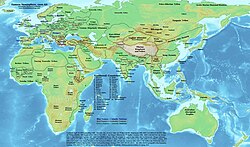
Map of the Eastern Hemisphere in the year of 1200 CE.
Maps depicting the Later Post-Classical period.

Expansion and division of the Mongol Empirefrom 1204 to 1294

Spread of Eurasian Black Death outbreak (1346–1351)
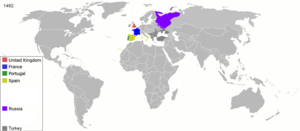
European Colonial Empires in 1492 CE, eve of Age of Discovery
Maps depicting Religion and Trade

Extent of Silk Route/Silk Road. Red is land route and the blue is the sea/water route.

State Religions of the Old World in the year of 820 CE, does not account for minorities.

Distribution of religion in the Old World during the 15th century.
Text is available under the Creative Commons Attribution-ShareAlike License
